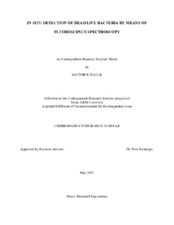| dc.creator | Walck, Matthew Alexander | |
| dc.date.accessioned | 2017-10-10T20:29:18Z | |
| dc.date.available | 2017-10-10T20:29:18Z | |
| dc.date.created | 2017-12 | |
| dc.date.submitted | December 2017 | |
| dc.identifier.uri | https://hdl.handle.net/1969.1/164546 | |
| dc.description.abstract | Bacterial infections cause thousands of deaths every year. A method for fast, in situ detection of bacteria and confirmation of their live/dead status would be invaluable. Excitation-emission matrices (EEMs) and synchronous fluorescence spectroscopy were used to study both individual bacterial components and whole bacteria and their reaction to ultraviolet radiation. Principle Component Analysis (PCA) was used to identify and plot the differences between the spectra. The results from these experiments have led to the development of a method of detecting bacteria and determining their viability. The results from this research will allow better prevention of infection and treatment of wounds. | en |
| dc.format.mimetype | application/pdf | |
| dc.subject | bacteria | en |
| dc.subject | synchronous | en |
| dc.subject | fluorescence | en |
| dc.subject | spectroscopy | en |
| dc.subject | principle component analysis | en |
| dc.subject | PCA | en |
| dc.subject | handheld spectrometer | en |
| dc.title | In Situ Detection of Dead/Live Bacteria by Means of Fluorescence Spectroscopy | en |
| dc.type | Thesis | en |
| thesis.degree.department | Electrical & Computer Engineering | en |
| thesis.degree.discipline | Electrical Engineering | en |
| thesis.degree.grantor | Undergraduate Research Scholars Program | en |
| thesis.degree.name | BS | en |
| thesis.degree.level | Undergraduate | en |
| dc.contributor.committeeMember | Rentzepis, Peter M | |
| dc.type.material | text | en |
| dc.date.updated | 2017-10-10T20:29:18Z | |


